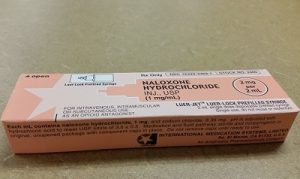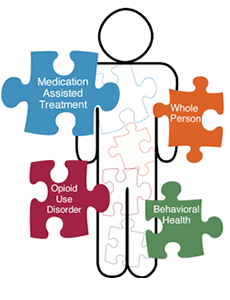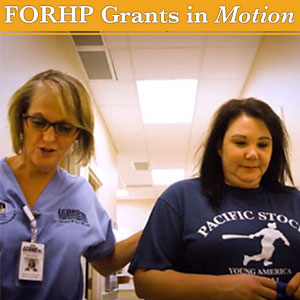Rural Response to the Opioid Crisis
This guide will help you learn about activities underway to address the opioid crisis in rural communities at the national, state, and local levels across the country. It identifies:
- Initiatives and funding opportunities
- Rural program examples
- Tools and resources focused on prevention, harm reduction, and treatment
For a more comprehensive review of how substance abuse, including opioid misuse, affects rural communities, please see the Substance Use and Misuse in Rural Areas topic guide, and in particular What is opioid abuse, and what effect has it had in rural communities?
Federal & Other National Initiatives Targeting Rural Communities
The federal government has committed significant resources to understanding and responding to the opioid crisis, and other national organizations serving rural areas are also taking an interest. Here are some of the initiatives specifically focused on rural areas:
Rural Communities Opioid Response
Program
Federal Office of Rural Health Policy (FORHP), Health Resources and Services
Administration (HRSA)
This multi-year initiative aims to reduce the morbidity and mortality of substance use disorder, including
opioid use disorder, in high risk rural communities. It includes funding for planning, implementation,
medication-assisted treatment
(MAT), neonatal
abstinence syndrome (NAS), rural
centers of excellence at the University of Vermont, University of Rochester, and The Fletcher Group to advance broader implementation of best
practices, technical assistance to support RCORP grantees, and an
evaluation of the RCORP program. In
addition, FORHP has also funded programs through the previously offered Rural
Health Opioid Program (RHOP) and Rural
Opioid Overdose Reversal Grant Program (ROOR).
Drug
Overdose in Rural America as a Public Health Issue
Centers for Disease Control and Prevention (CDC)
Learn about overdose deaths in rural areas, policy options to address the opioid crisis, and CDC resources
related to preventing drug overdose.
Rural Opioid Technical Assistance (ROTA)
Substance Abuse and Mental Health Services Administration
A program to develop and disseminate training and technical assistance for rural communities on addressing
opioid issues affecting these communities. ROTA
grantees have been announced and the 2018
funding announcement provides background information.
NHSC Substance Use Disorder/Opioid Expansion Site Initiative
National Health Service Corps
Expands and improves access to quality opioid and substance use disorder treatment in rural and underserved
areas. NHSC also launched the NHSC Rural Community
Loan Repayment Program and the
NHSC Substance Use
Disorder Workforce Loan Repayment Program for recruiting and retaining providers to expand access to
treatment.
Opioid Use Disorder and Pain
Indian Health Service (IHS)
A central resource for sharing information and increasing communication related to opioids with tribal
stakeholders. Addresses pain management, prevention strategies, treatment, and crisis response. Also includes
information on the IHS National Committee on Heroin Opioids and Pain Efforts (HOPE).
Additional Opioid Resources Relevant to Rural Communities
In addition to the rural-focused efforts highlighted above, the federal government is also responding to the opioid crisis with resources relevant to all types of communities, including rural areas:
HHS.gov/Opioids: Help and Resources, National Opioids
Crisis
U.S. Department of Health & Human Services (HHS)
Resources to help locate treatment, offering an overview of the opioid epidemic as well as resources and
information for prevention, treatment, and recovery.
HRSA's Response to the Opioid Crisis
Health Resources and Services Administration (HRSA)
Highlights efforts underway at HRSA to address the opioid crisis, including expanding access, use of telehealth,
primary care training, and more. Also identifies HRSA-supported resources and technical assistance centers.
Drug Overdose Deaths in the United States
NORC at the University of Chicago, U.S. Department of Agriculture
Interactive map providing access to county-level drug overdose deaths, including deaths due to opioid overdose.
Includes the option to overlay socioeconomic data and limit to rural or urban counties.
CMS
Roadmap: Strategy to Fight the Opioid Crisis
Centers for Medicare and Medicaid Services
Highlights the efforts underway at CMS to address the opioid epidemic focused on prevention, treatment, and data
utilization to target prevention and treatment activities. Includes some information specific to rural areas.
CDC Opioid Overdose Prevention
Centers for Disease Control and Prevention (CDC)
Information to help patients, providers, and the public understand opioids and learn how to prevent opioid
overdose. Provides access to data and CDC reports on the opioid crisis.
NIDA Opioids Research
National Institute on Drug Abuse (NIDA)
Provides an overview of opioid misuse treatment and overdose rates, and describes efforts of the National
Institutes of Health (NIH) to address the issue. Includes related NIDA/NIH resources, as well as resources from
other federal sources. NIDA is coordinating the HEALing Communities Study,
which focuses on communities hard hit by the opioid crisis, including several rural counties.
Evidence-Based
Practices Resource Center
Substance Abuse and Mental Health Services Administration (SAMHSA)
A collection of resources to help incorporate evidence-based practices into communities and clinical settings.
Includes opioid-specific resources.
Addiction Technology Transfer Center (ATTC) Network
Substance Abuse and Mental Health Services Administration (SAMHSA)
10 centers across the U.S. that serve as resources to accelerate the adoption and implementation of
evidence-based and promising addiction treatment and recovery-oriented practices and services, including work
focused on addressing
opioid misuse.
Prevention Technology Transfer Center (PTTC) Network
Substance Abuse and Mental Health Services Administration (SAMHSA)
12 centers across the U.S. to improve implementation and delivery of effective substance abuse prevention
interventions and provide training and technical assistance services to the substance abuse prevention field.
Center of Excellence for
Integrated
Health Solutions
National Council for Behavioral Health
Resources, models, training, and technical assistance for developing integrated primary and behavioral health
services to better address the needs of individuals with mental health and substance use conditions.
Facing
Addiction in America
U.S. Surgeon General
Reports and information related to addiction, with a special focus on resources to address the opioid crisis.
Combating the Opioid
Epidemic
Office of the Inspector General (OIG), U.S. Department of Health & Human Services (HHS)
Describes efforts underway at the OIG to address the opioid crisis by identifying opportunities to improve HHS
programs, detecting and addressing fraud, and sharing data and methods with partners. Includes related reports
and resources.
Action
Collaborative on Countering the U.S. Opioid Epidemic
National Academy of Medicine, Aspen Institute, 30+ Additional Organizations
A public-private partnership focused on sharing knowledge related to the opioid crisis, aligning initiatives,
and advancing shared solutions.
CDC TRAIN: Opioid
Training
Public Health Foundation
A wide range of public health training opportunities related to the opioids, including recorded webcasts and
self-study. Includes training from the federal agencies and national organizations.
Foundation for Opioid Response Efforts
Grantmaking Foundation
Supports programs that respond to the opioid crisis, funding professional education, payer and provider
strategies, public awareness, and policy efforts.
Funding
The Funding & Opportunities section of this guide identifies grants aimed at addressing the opioid crisis, with a focus on national opportunities available to rural and tribal communities.
The HRSA Bureau of Health Workforce offers several behavioral health grant programs to help expand the substance abuse and behavioral health workforce.
For additional state and regional funding, see the Online Library: Funding & Opportunities lists for Illicit drug use and Prescription drug misuse. For national programs that more broadly address substance use, including national and state opportunities, see Substance use and misuse.
Key Rural Resources
 The
Rural Substance Use Disorders Prevention, Treatment, and Recovery Toolkit
presents
resources, models, and program examples to guide the development and implementation of successful substance
abuse prevention and treatment programs for rural communities. In the sections below, you'll find program models
from this toolkit that can be used to address specific aspects of opioid treatment and prevention.
The
Rural Substance Use Disorders Prevention, Treatment, and Recovery Toolkit
presents
resources, models, and program examples to guide the development and implementation of successful substance
abuse prevention and treatment programs for rural communities. In the sections below, you'll find program models
from this toolkit that can be used to address specific aspects of opioid treatment and prevention.
Rural Community
Action Guide: Building Stronger, Healthy, Drug-Free Rural Communities
Provides an overview of challenges rural communities face related to substance use disorder. Identifies action
steps rural communities can take related to prevention, treatment, recovery, and SUD-related issues such as
stigma, transportation barriers, and lack of employment opportunities. A Promising
Practices Supplement describes programs working to address these issues in rural communities.
Rural Health Research Gateway:
Substance Use and Treatment
Provides access to research findings on opioid use and treatment from research centers funded by the Federal
Office of Rural Health Policy. Also lists projects currently underway.
Rural
Opioid Abuse Prevention and Treatment Strategies: The Experience in Four States
Also from the Maine Rural Health Research Center, an April 2017 paper examining strategies for dealing with the
rural opioid crisis, including prevention, treatment, and recovery services. Uses data from interviews with key
stakeholders in Indiana, North Carolina, Vermont, and Washington.
Rural Opioid Educational Resources
A comprehensive list of National Organization of State Offices of Rural Health resources addressing the opioid
crisis. Includes reports, webinar recordings, promising practices, training materials, and medication-assisted
treatment (MAT) resources. Also offers customizable posters, flyers, brochures, and more.
RCORP-TA Trainings and Resources
A searchable collection of publications, training materials, and templates from RCORP-TA (Rural Communities
Opioid Response Program – Technical Assistance), to support grantees of the RCORP program. Includes
options to
narrow resources by issue addressed, population targeted, type of resource, and more.
Comprehensive Approaches
The following rural programs take a broad approach to addressing opioid misuse, combining a variety of interventions:
-
Communities of Practice for Rural Communities Opioid
Response Program (CoP-RCORP)
This Ohio consortium helps rural communities in a 5-county area build capacity and work across the continuum of care. CoP-RCORP was featured in the November 2019 Rural Monitor article, Creating a Consortium to Combat the Opioid Epidemic in Ohio. -
Project Lazarus
To counter the high death rates related to opioid overdoses in Wilkes County, North Carolina, Project Lazarus equips prescribers, patients, and communities with education and tools needed to lessen the drug supply and demand and lower death rates.
Additional programs focused on particular aspects of the opioid response are identified below.
|
Federal and state agencies are funding research studies and collecting and sharing a wide range of data to help understand the opioid crisis, so it can be responded to effectively. Recent areas of study include the use of opioids in combination with other substances and the impact of the COVID-19 pandemic on opioid misuse. The USDA has conducted rural roundtables in seven states focused on opioid misuse. Learn more in this 2018 Rural Monitor interview: USDA Road Trip Through Rural America: Q&A with Anne Hazlett |
|
| Research in Progress from the Rural Health Research Centers |
Prevalence of Opioid Prescribing, Diagnoses of Opioid Use Disorder, Treatment Patterns, and Costs Among Rural Medicare Beneficiaries, FORHP-funded study by the Maine Rural Health Research Center |
|---|---|
| Findings from Rural Health Research |
Opioid Use and Treatment Availability – Rural Health Research Recap summarizing findings from FORHP-funded rural health research center studies. University of Minnesota Rural Health Research Center
Rural and Underserved Health Research Center
Maine Rural Health Research Center |
| Additional Resources |
Opioid Use and Treatment Availability – Rural Health Research Recap summarizing findings from FORHP-funded rural health research center studies. Opioid-Related Hospital Use – National data on inpatient stays and emergency department visits by level of rurality. To access rural data, select the Trend Graph or Trend Table view and select Patient location under Characteristics. MMWR Opioid Reports – Lists reports in the Morbidity and Mortality Weekly Report focused on opioid misuse. Many of these reports include data on rural opioid use. Drug Overdose Deaths in the United States – Interactive map identifying drug overdose deaths by county, along with related sociodemographic and economic information. Data Sources and Data-Linking Strategies to Support Research to Address the Opioid Crisis – Identifies data sources available to conduct research on the opioid crisis and describes methods for linking or merging these data sources. Toolkit: Using Data Analysis To Calculate Opioid Levels and Identify Patients At Risk of Misuse or Overdose – HHS Office of the Inspector General guide for using prescription drug claims data to analyze patients' opioid levels and identify those at risk of opioid misuse or overdose. Rural Communities in Crisis: A Critical Count to Save Lives During the Opioid Epidemic – A toolkit and calculation tool rural communities can use to estimate the size and characteristics of the population who inject drugs, in order to estimate service needs. See the Resources section of this guide for many additional reports and other resources describing the rural opioid crisis. |
Prevention
| Helping rural community members learn about the opioid crisis can reduce stigma and increase support for treatment options. Programs may cover topics like risk factors related to substance use disorder, the physical process of addiction, and how different treatment approaches work. | |
| Rural Substance Use Disorders Prevention, Treatment, and Recovery Toolkit – Program Models |
Prevention Programs for Youth and Families |
|---|---|
| Resources |
Preventing Substance Misuse in Rural Settings – A guide to delivering substance misuse prevention programming in rural communities. Identifies challenges and strategies specific to rural areas. Using Evidence-Based Stigma Elimination Techniques – Presentation slide deck providing guidance on how to address stigma. |
| Avoiding unnecessary use of opioids is a key method of preventing opioid misuse before it starts. Rural healthcare providers are addressing pain management and opioid prescribing to help protect their patients. | |
| Resources |
U.S. Opioid Dispensing Rate Maps – County-level prescription dispensing rate maps from the CDC. Pain Management Best Practices Inter-Agency Task Force: Updates, Gaps, Inconsistencies and Recommendations — Final Report – Identifies clinical best practices for managing chronic and acute pain. Indian Health Service: Pain Management – Resources to help address the challenges providers face helping patients with chronic pain while preventing illegal or harmful use of opioids. Rx Awareness – A CDC campaign to increase awareness of the danger of prescription opioids. Six Building Blocks: A Team-Based Approach to Improving Opioid Management in Primary Care – Provides a structured approach for improving management of patients on chronic opioid therapy. Offers a self-assessment and implementation guide. Quality Improvement and Care Coordination: Implementing the CDC Guideline for Prescribing Opioids for Chronic Pain – A guide to help primary care providers, practices, and healthcare systems manage patients who are on long-term opioid therapy. |
|---|---|
Harm Reduction
|
Programs that train rural first responders, community members, friends, and family members to administer naloxone to prevent an opioid overdose. For an overview of the role of naloxone in rural communities, see these 2016 Rural Monitor features: |
|
| Rural Substance Use Disorders Prevention, Treatment, and Recovery Toolkit – Program Models | Naloxone Expansion Programs |
|---|---|
| Resources |
SAMHSA Opioid Overdose Prevention Toolkit – Guidance for community members, first responders, prescribers, patients, and families in responding to an overdose, including information on administering naloxone. HRSA Poison Help Line – Connect to your local poison control center for free advice from medical professionals. 1-800-222-1222 |
| Strategies to prevent and treat the consequences of opioid injection, including HIV, hepatitis B and C infections, and other sexually transmitted diseases. | |
| Research in Progress from the Rural Health Research Centers |
Trends and Predictors of Human Immunodeficiency Virus (HIV) in Light of the Opioid Crisis Along the Urban-Rural Continuum, FORHP-funded study by the Southwest Rural Health Research Center |
|---|---|
| Resources |
Tackling the Trifecta: State Approaches to Addressing Co-Occurring Substance Use Disorders, HIV, and Hepatitis C – National Academy for State Health Policy report on innovative approaches to address co-morbidities. Includes rural perspectives. Opportunities to Improve Opioid Use Disorder and Infectious Disease Services: Integrating Responses to a Dual Epidemic – Report from the Health and Medicine Division of the National Academies of Sciences, Engineering, and Medicine focused on integrating infectious disease and opioid use disorder services. Integrating Responses at the Intersection of Opioid Use Disorder and Infectious Disease Epidemics – Proceedings from a workshop focused on the link between the opioid crisis and infectious disease such as HIV and HCV. Includes rural information. The workshop presentations are also available. Infectious Diseases and Opioid Use Disorder (OUD) Policy Issues and Recommendations – A report that highlights policy considerations, including those focused on rural settings, for addressing infectious disease linked to injection drug use. The Intersection of Hepatitis, HIV, and the Opioid Crisis: The Need for a Comprehensive Response – An issue brief from NASTAD (the National Alliance of State and Territorial AIDS Directors) that includes suggested public health actions. Managing HIV and Hepatitis C Outbreaks Among People Who Inject Drugs: A Guide for State and Local Health Departments – A guide from the CDC, with information on outbreak preparedness and detection, investigation, and response. A Guide to Establishing Syringe Services Programs in Rural, At-Risk Areas – Provides an overview of syringe services programs and discusses issues specific to rural areas. Includes examples of rural syringe exchange programs. Determination of Need for Syringe Services Programs – CDC guidance on how states, tribes, and territories can request a determination of need for SSPs, which would allow use of federal funds to support this service. Threading the Needle – How to Stop the HIV Outbreak in Rural Indiana – A New England Journal of Medicine perspective piece describing steps taken to address an HIV outbreak tied to injection drug use. |
| Strategies to address the misuse of other substances in conjunction with opioid use, as well as mental health issues like depression and suicide that often go hand-in-hand with opioid use disorder. | |
| Evidence-Based Toolkits for Rural Community Health – Program Models | |
|---|---|
| Resources |
Drug Overdose Deaths Involving Cocaine and Psychostimulants with Abuse Potential – United States, 2003–2017 – MMWR (Morbidity and Mortality Weekly Report) article that includes data for metropolitan, micropolitan, and non-core counties. Nonfatal Drug and Polydrug Overdoses Treated in Emergency Departments — 29 States, 2018–2019 – MMWR (Morbidity and Mortality Weekly Report) article that includes rural/urban data on opioid use in combination with other types of drugs. Suicide Prevention Resource Center – Federally supported resource center devoted to advancing the implementation of the National Strategy for Suicide Prevention. Includes resources and guidance for developing effective suicide prevention programs. Treatment of Stimulant Use Disorders – SAMHSA guide that discusses effective practices to treat stimulant use disorders, clinical challenges associated with these disorders, and implementation strategies that can be used to address those challenges. |
Treatment
| Access to treatment in rural communities depends on ensuring that healthcare providers have the training and credentials to offer needed services. | |
| Evidence-Based Rural Programs |
Project ECHO® — Extension for Community Healthcare Outcomes – Provides rural providers with ongoing education and mentoring from specialists. |
|---|---|
| Resources |
Integrating Opioid Use Disorder Treatment Into Health Workforce Training – Recording of a webinar focused on health workforce training related to treating opioid use disorder. Includes case studies from Colorado and Nevada. Substance Use Warmline – Teleconsultation to support primary care providers in managing complex patients with addiction, chronic pain, and behavioral health issues. Caring for Women with Opioid Use Disorder: A Toolkit for Organization Leaders and Providers – Offers resources to support coordinated care delivery for women with OUD, covering engagement in care, critical partnerships to improve care coordination, and cultural shifts regarding addiction and treatment. |
|
MAT is a treatment approach that combines counseling and behavioral therapy with medication to block
the impact of opioids on the brain. For insights about the use of MAT in rural areas, as well as
background information explaining how MAT works, see these 2018 Rural Monitor articles:
|
|
| Related Toolkit Resources | |
|---|---|
| Additional Rural Program Example |
MIST: Mothers and Infants Sober Together |
| Grants Awarded for Rural Projects |
In 2018, Patient-Centered Outcomes Research Institute announced
$10 million to study MAT use in pregnant women:
Primary Care Medication-Assisted Treatment for Opioid Use Disorder Grantees – An Agency for Healthcare Research and Quality initiative to support rural primary care practices in delivering medication-assisted treatment (MAT). |
| Findings from Rural Health Research |
Rural and Underserved Health Research Center
WWAMI Rural Health Research Center
|
| Additional Resources |
Implementing Medication-Assisted Treatment for Opioid Use Disorder in Rural Primary Care: Environmental Scan, Volume 1 and Volume 2 (Tools and Resources) – Agency for Healthcare Research and Quality reports that summarize findings from the literature and identify tools to support MAT. Buprenorphine and the Opioid Crisis: A Primer for Congress – Congressional Research Service report examining the effectiveness of, demand for, and access to buprenorphine. Location of Medication-Assisted Treatment for Opioid Addiction: In Brief – Congressional Research Service report that discusses the availability of MAT and policy options for rural access to MAT. Medication-Assisted Treatment (MAT) Training and Mentoring/DATA 2000 Waiver – Free training and mentoring for eligible healthcare providers to obtain a waiver allowing them to deliver MAT. Providers with a DATA 2000 Waiver are priority applicants for some National Health Service Corps loan repayment programs. |
| Health care providers, law enforcement, community organizations, friends, and family
members are working together to make it easier for people to get needed care for opioid addiction.
|
|
| Rural Substance Use Disorders Prevention, Treatment, and Recovery Toolkit – Program Models | |
|---|---|
| Evidence-Based Rural Programs |
Vermont Hub-and-Spoke Model of Care for Opioid Use Disorder |
| Additional Rural Program Examples |
ASPIN Network's Certified Recovery Specialist Program
Addiction Recovery Mobile Outreach Team (ARMOT)
Seneca Strong's Certified Recovery Peer Advocates
Opioid
Use Disorder: Challenges and Opportunities in Rural Communities |
| Research in Progress from the Rural Health Research Centers | Treatment, Provider, and Cost Differences for Rural and Urban Patients with Opioid Use Disorder Across the U.S., FORHP-funded study by the WWAMI Rural Health Research Center |
| Findings from Rural Health Research |
Rural and Underserved Health Research Center |
| Additional Resources |
FindTreatment.gov – A substance abuse treatment locator, searchable by type of treatment offered and other factors. Become an NHSC Site – Information on eligibility and application instructions for becoming a National Health Service Corps site, which allows facilities to recruit and hire NHSC providers, including those specializing in mental and behavioral health. The NHSC has added new categories of outpatient services and sites eligible for NHSC to address the opioid crisis. Opioid Epidemic Practical Toolkit: Helping Faith and Community Leaders Bring Hope and Healing to Our Communities – Center for Faith-based and Neighborhood Partnerships toolkit providing practical steps that community and faith-based organizations can take to help address the opioid crisis. The Partnership Center also offers a collection of videos. The Opioid Use Disorder Prevention Playbook – Identifies 11 evidence-based strategies communities can use to help address the opioid crisis. Opioid Treatment Programs – Information and resources from CMS related to the Medicare Part B benefit for opioid use disorder (OUD) treatment services. Movable: Narratives of Recovery and Place – Shares narratives on recovery from substance and alcohol use disorders in Appalachia and beyond. |
| Rural Substance Use Disorders Prevention, Treatment, and Recovery Toolkit – Program Models | Telehealth Models |
|---|---|
| Evidence-Based Rural Programs | Project ECHO is an evidence-based approach where primary care providers and specialists work as a team to manage chronic complex conditions of rural patients and to increase the knowledge base through shared case studies. |
| Resources |
Rural Health Care and Medicaid Telehealth Flexibilities, and Guidance Regarding Section 1009 of the Substance Use-Disorder Prevention that Promotes Opioid Recovery and Treatment (SUPPORT) for Patients and Communities Act (Pub. L. 115-271), entitled Medicaid Substance Use Disorder Treatment via Telehealth – Guidance from CMS on the use of telehealth to provide substance use disorder treatment. The Special Registration for Telemedicine: In Brief – Congressional Research Service report describing changes to the Controlled Substance Act (CSA) authorizing the use of telemedicine to help address the opioid crisis. Using Telehealth to Identify and Manage Health and Substance Use Disorder Conditions in Rural Areas – Describes how telehealth supports substance use disorder treatment, with focus on treatment of opioid use disorders in rural areas. Integrating Telemedicine for Medication Treatment for Opioid Use Disorder in Rural Primary Care: Beyond the COVID Pandemic – Highlights the successes of telehealth expansion during COVID-19 and suggests ways it could be used to increase access to medication treatment for OUD. |






 For examples of how three rural communities are using federal Rural Health Opioid Program
funding to provide treatment and recovery care coordination, see this 2018 Rural
Monitor
story:
For examples of how three rural communities are using federal Rural Health Opioid Program
funding to provide treatment and recovery care coordination, see this 2018 Rural
Monitor
story: